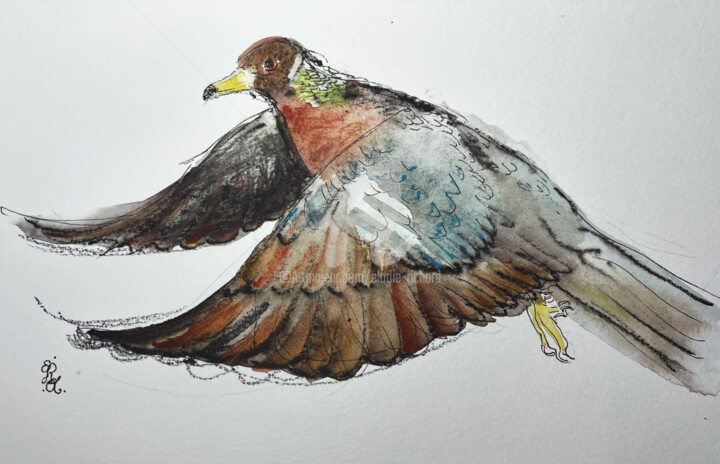


让我们知道您是否想看到这件艺术品的更多照片!
- 工作的背面 / 工作的一面
- 细节 / 签名 / 艺术品的表面或纹理
- 情境中的艺术品, 其他...
Rescued Band Tailed pigeon, 2 (Original)(Oregon, USA) (2024) 绘画 由 Elodie M. Richard
更多信息
- 包装 (信封) 所有的作品都配有优质的承运方,经过严格的包装保护和已投保。
- 监控 跟踪订单,直到包裹交付给买方. 将提供跟踪号码,以便您可以实时跟踪包裹。
- 延迟 全球配送会在3-7天内送达 (估计)
更多信息
- 可追踪的在线真品证书 可以通过扫描插图的代码随时在线验证真品证书。
- 认证评级艺术家 专家研究一个艺术家的工作和职业生涯,然后建立一个独立的,可靠的平均价格值。平均价格价值座落在一个价格范围内的某一时期的艺术家。专家们也可能被要求建立一个更精确的估计为特定的工作。
更多信息
使用SSL证书进行100%安全付款 + 3D Secure.
更多信息
-
限量版 (#298/300)
绘画,
水彩
/
圆珠笔
/
颜料
在纸上
- 可用份数 1
- 外形尺寸 高度 7in, 宽度 10in
- 艺术品状况 艺术品完好无损
- 是否含画框 此作品未装裱
- 分类 画作 低于US$500 插图 鸟
My friend, Shonda, found an injured band tailed pigeon in her side yard in Phoenix, Oregon. Band tailed pigeons are a wild, native species of pigeon. They migrate up and down the Pacific Coast and Mexico and breed in Utah, New Mexico, Arizona and Colorado. The Pacific Coast population of band-tailed pigeons has experienced a long population decline. The North American Breeding Bird Survey indicates an average loss of 2% per year of this species since 1968 due to our forest management practices, the decline in Valley Oak and Blue Oak ecosystems, urban sprawl, and the species’ low reproductivity rate. Band tail pigeons usually have only one squab a year.
The injured band tail appeared to have been hawk-struck. The poor bird had a giant, gaping hole in its crop with seed pouring out. I was called to help since I have a sanctuary for rescued, largely domesticated pigeons in Jacksonville, Oregon, a town nearby. Shonda’s friend, Phil, had taken two pictures of the bird: one of the wound and one of the back of the pigeon. From the pictures, I thought the injured bird was a Eurasian collared dove. I called my avian vet and asked if she could see it to do a crop repair. She refused. Her license as a veterinarian prevented her from seeing (and helping) wild animals, of any kind.
Shonda’s friend, Phil, called Wildlife Images. Wildlife Images is Oregon’s state rehabber. Wildlife Images is charged with rehabilitating injured, native wildlife in Oregon. It refused to take the bird too. From the pictures Phil forwarded, Wildlife Images determined that the bird was too badly injured to be rehabilitated and returned to the wild. Also, the bird was likely non-native and hence was not within the purview of the state rehabber. (This, of course, ended being untrue. Band tailed pigeons are native to Oregon.)
So, Shonda, Phil and I were left with nowhere to turn. None of us knew any individual rehabbers in Southern Oregon or thereabouts, and time was of the essence in helping this bird if it was going to live. Shonda watched four (4) hours of YouTube videos about pigeon anatomy and how to stitch up a crop tear. Unwillingly, she took on the insane task of stitching up this bird’s crop. Having nursed scores of pigeons back to health from sickness and injury (including several crop repair surgeries), I knew the importance of immediate antibiotics and a painkiller. My husband, Steve, and I poured through all the leftover medicine from years of avian vet visits for our rescues and found a general spectrum antibiotic (Baytril), some meloxicam (a pain killer) and an antibiotic ointment for around the wound (silver sulfadiazine ointment (“silver”). Steve drove these antibiotics to Shonda at 9 pm that first night.
All of us felt certain our crazy undertaking was going to fail, and that the bird would not live through the night. But, unbelievably, she did. As of this writing, we are on Day 11. The bird was quickly identified as a band tailed pigeon, not a dove. She initially could do little on her own. She had to be encouraged to eat and drink. Shonda held a bowl of seed and a glass of water for the pigeon, so that the band tail could reach it without touching her sensitive wound. She couldn’t fly.
As the days passed, she has cleared most of the hurdles to returning to the wild. She can eat and drink on her own now, and we have taken pains to ensure that she gets her wild diet of seed, ground acorns and berries. She preens herself, and she even laid an egg! Happy Day! And, yesterday, she started flying to a target (like a perch, ceiling fan, or her cage top), rather than crashing into a wall or door. She finished her 10 days of antibiotics. Release is so close now! A little more healing of her wound is necessary as the skin has pulled open slightly. And, we all would like to see her take stronger flight and watch her take a bath before our last day with this beautiful, wild creature »
After a successful recovery, the band tail was finally moved into an outside cage. She could adjust to the outside temperature and finish the week or weeks left of growing back all of her feathers over the crop tear and getting as strong as possible. An outside cage also minimized any more human contact.''
The Band tailed pigeon was successfully released to the wild on April 14 th.
相关主题
Calltopigeon2024ElodiemrichardartprojectRescuedbandtailedpigeonWildpigeonoforegonusaEndspeciecism
Elodie M. Richard was born in France but with a complex heritage including Polish and Russian. Due to her father’s career in the Army her family had to regularly move and adapt to new locations in France and abroad. Her life path as a child and adult is made of travels and regular changes of geographical locations, constantly balancing between feeling of loss, challenges and new life starts.
Unlike a superficial society that gets lost in ultra consumption, Elodie creates a refined, symbolic and meditative world around the broad notion of identity. She takes her inspirations from personal experiences but also current events and her connection to nature.
The artist currently lives in Central Florida with her husband (artist himself) and their small flock of 5 rescued pigeons.
This page shows an inventory of her work as a painter and illustrator since 2016 up to this current year.
Some of her artworks appear as sold, if interested in an art piece, please private message Elodie.
-
国籍:
法国

- 出生日期 : 1975
- 艺术领域: 具有认证艺术家价值的艺术家的作品,
- 团体: 认证的艺术家 当代法国艺术家







